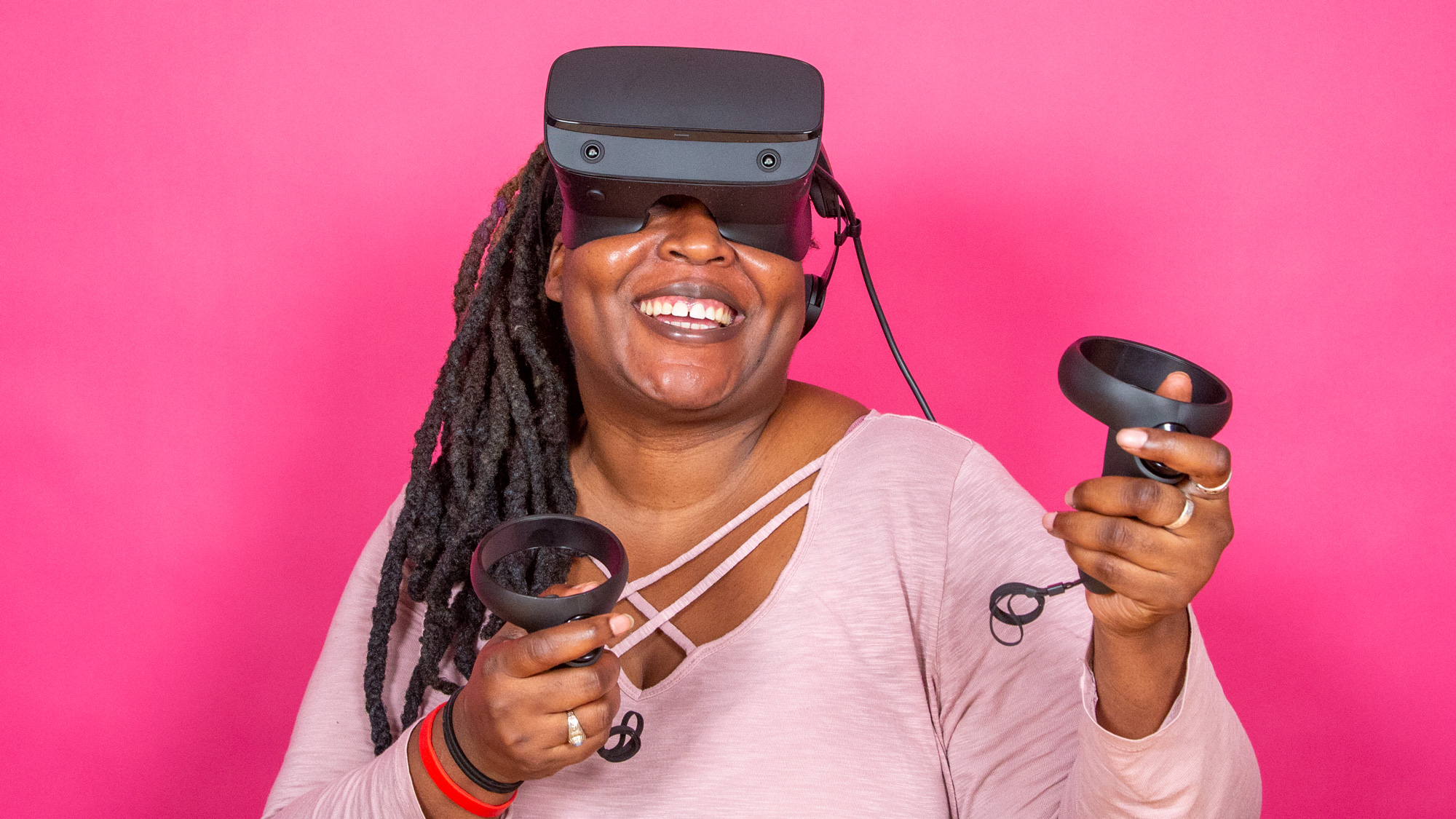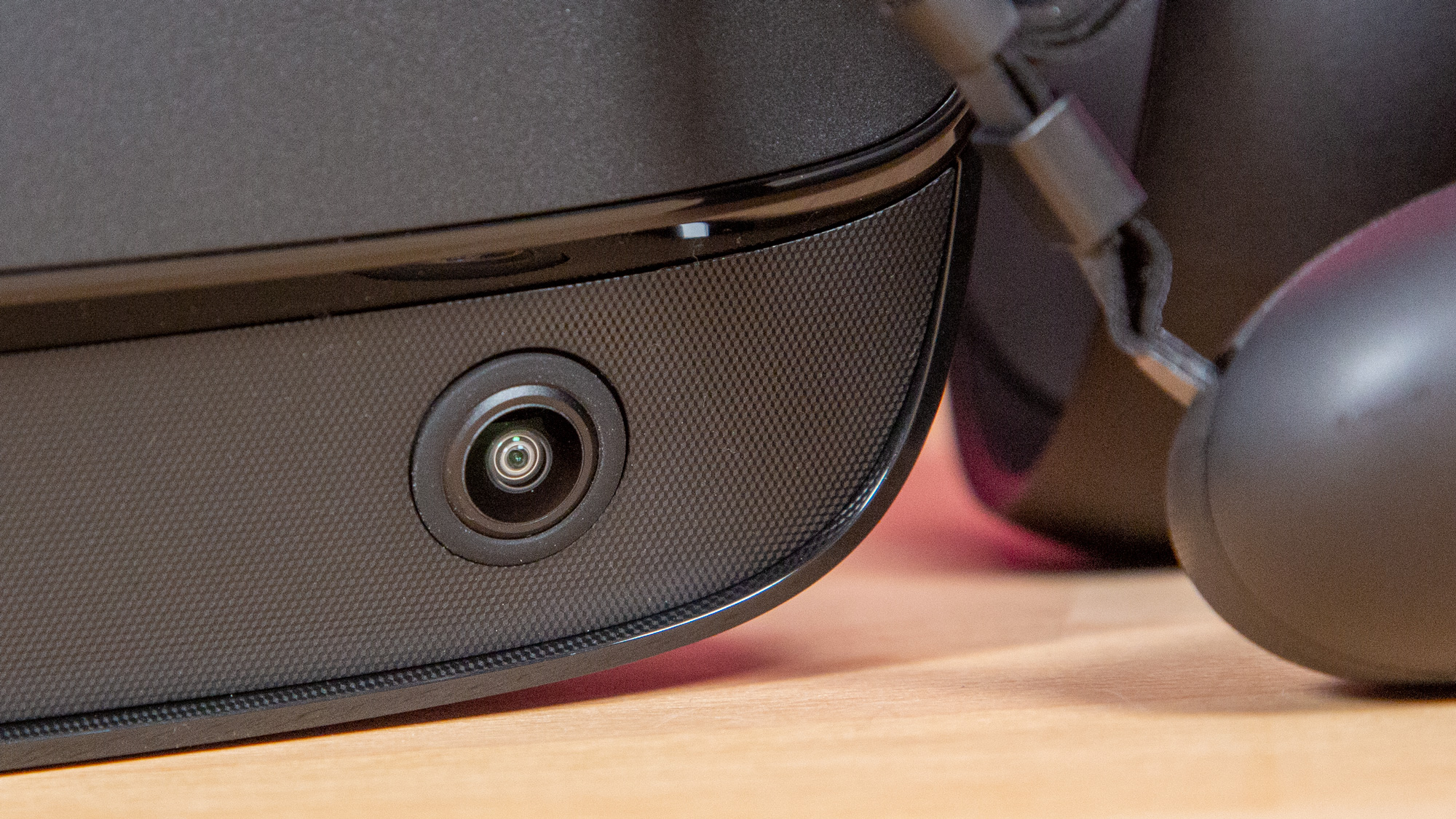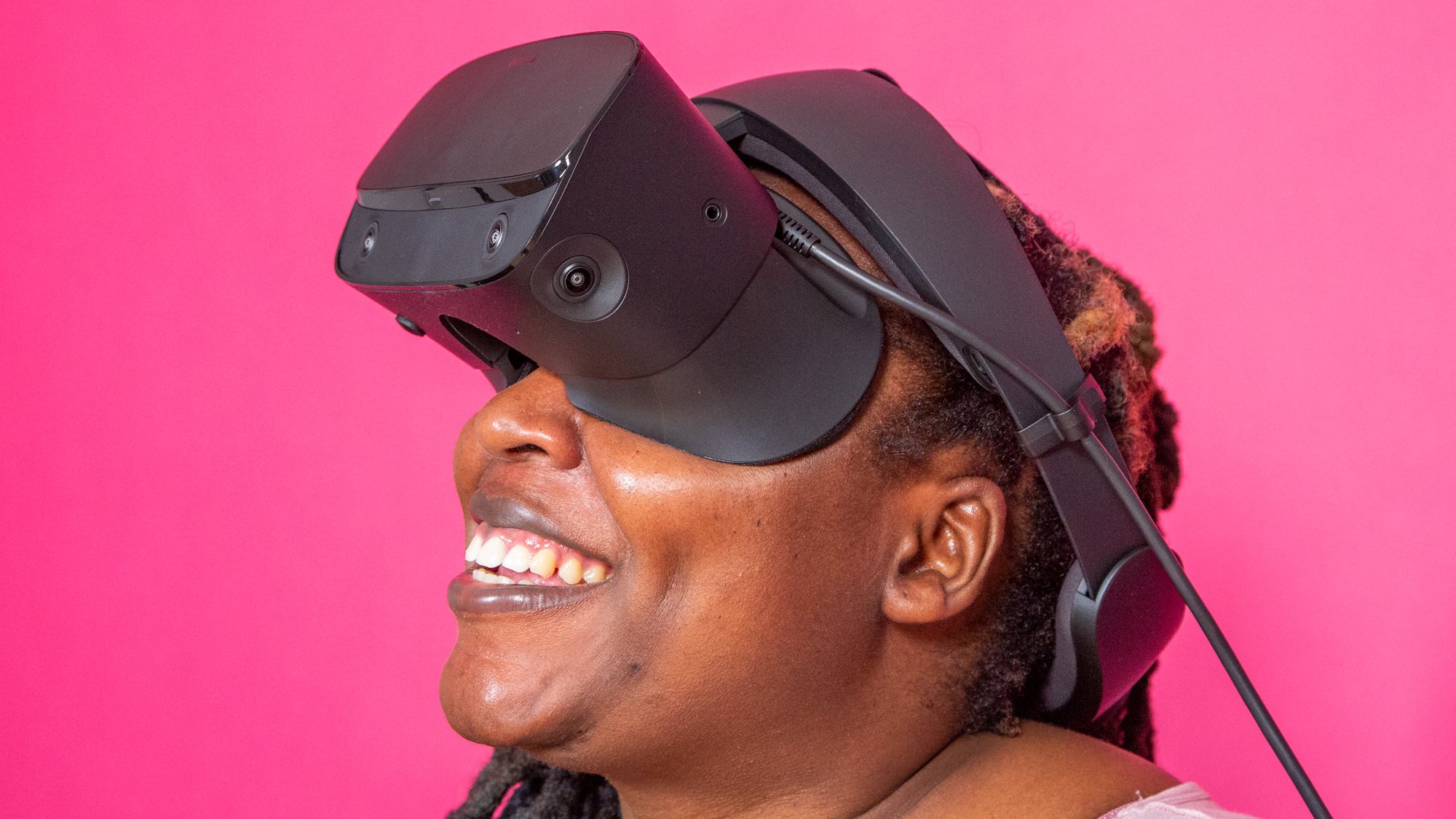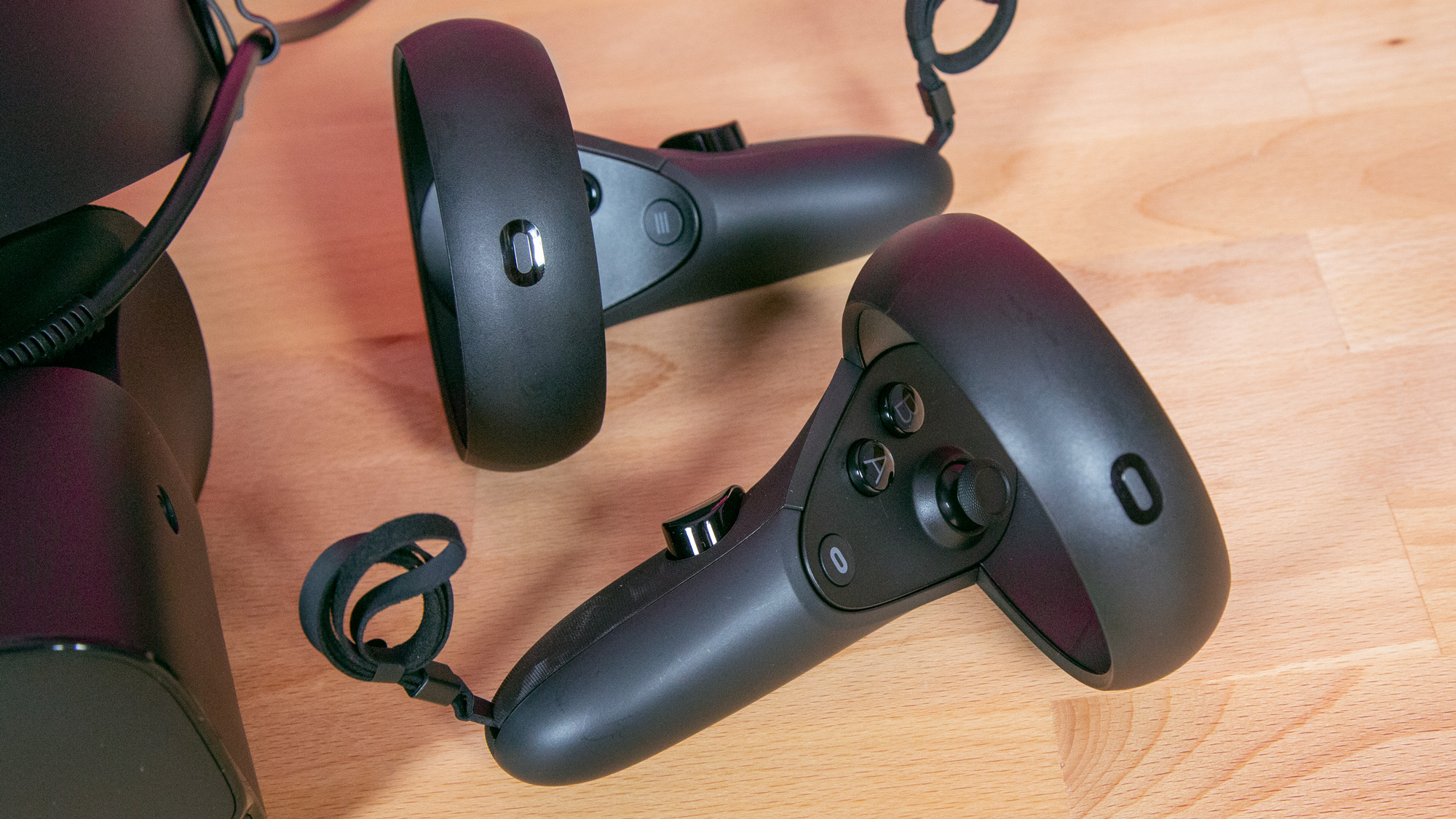Laptop Mag Verdict
The Oculus Rift S sports a smart, comfy design and a gorgeous display, and it supports a ton of games, but the controllers could be more ergonomic.
Pros
- +
Smart, comfortable design
- +
Sharp, gorgeous display
- +
Wide selection of games and apps
- +
Affordable
Cons
- -
Controllers could be more ergonomic
- -
Oculus app is still too basic
Why you can trust Laptop Mag
Thanks to the $399 Oculus Rift S, owning a VR headset is actually getting affordable. But affordable doesn't mean cheaply made; this baby has a smart and comfortable design, an immersive display, and a wide selection of games and apps. This is a great VR headset option if you already own a gaming laptop. Still, the controllers could be more ergonomic, and the Oculus app needs a tuneup. But overall, the Oculus Rift S is the best VR headset for the money you can buy right now.
Oculus Rift S price and availability
You can pick up the Oculus Rift S right now for just $399, which is pretty affordable for VR when you consider that the cost is close to that of current-gen consoles like the Xbox One X ($399), PlayStation 4 Pro ($399) and Nintendo Switch ($299). We even saw the Oculus Rift S go down to $349 over Black Friday, and given the price of its current competitors, like the Vive Cosmos ($699) and Valve Index ($999), it's the most affordable PC-powered VR headset you can buy.
Oculus Rift S design
At first glance, the Oculus Rift S may seem bulkier than the previous Oculus Rift, but it's actually a more compact and simpler version, with fewer moving parts.
The face of the Rift S is not as curved as that of its predecessor. There's an Oculus logo at the top of the faceplate, with an LED indicator and two cameras on the bottom half. There are three additional cameras on the headset located at the top as well as the right and left sides. That means no outside sensors needed (whew). That's right — you can put the base stations away, as the headset does all of its own tracking.

The interior of the Oculus Rift S has two big lenses, a rubber cutout for the nose and a foam cushion surrounding the goggles. An LED indicator coupled with an integrated sensor between the lenses detects whether you're wearing the headset. Two small, bottom-mounted speaker vents replace the big ol' speaker cups of the previous model.

There's a cutout for the 16.4-foot cable on the top that leads to a DisplayPort and USB Type-A port. You also get a Mini DisplayPort adapter so you can connect to a gaming laptop. This is honestly amazing, considering that the Vive Cosmos doesn't come with such an adapter. Along the left of the Oculus Rift S is a headphone jack. The bottom has a button to adjust the forward slide of the headset and a small dot for the microphone.
The headset is secured with a series of straps along the top, sides and back. A large dial on the back strap can be adjusted for fit.
Sign up to receive The Snapshot, a free special dispatch from Laptop Mag, in your inbox.
Weighing 1.2 pounds and measuring 10.8 x 3.7 x 5.2 inches, the Rift S is relatively light and slim. For context, the Vive Cosmos weighs 1.5 pounds and stacks up to 7.5 x 4.6 x 5.6 inches, so that headset's a little heavier but has a slightly smaller footprint.
Oculus Rift S setup
Setting up the Oculus Rift S was super simple and, honestly, a great introduction to VR in general.
Obviously, you have to download the Oculus app, which you can find on the company's website. The Oculus folder took up 13.7GB on my computer, and that's counting everything from drivers to my Oculus Home (your own customizable hub), so the size will vary between people.

Once the app is downloaded, connect your Mini DisplayPort and USB Type-A cables to your laptop, slot one AA battery into each of your controllers, and finally put on the headset — wait, do you have 6.5 x 6.5-foot space free of objects? Don't worry — if you don't (like me), you can customize the Oculus Rift S' Guardian system to accommodate for the amount of space you have.
Once you let those gorgeous, 2560 x 1440 lenses blast you with a smooth, 80-Hz refresh rate, the system transitions to its transparent cameras. The Oculus will make you determine your height by touching the floor with a controller, and then you'll have to gauge how much space is in your room by outlining it with a brush. If you happen to get close to any of the walls you outlined, a blue outline of the walls will appear, turn red if you get close enough and then cut to full transparent mode so you can see where you are and readjust.
After you're done with the setup, Oculus will boot up one of its tutorials: Oculus First Steps, which throws you into a magical-looking sci-fi space with Disney-esque music. Then, a nice lady will explain how the Oculus Touch controllers work. When you're done with that tutorial, you get transitioned to the next one: Oculus First Contact, which introduces you to an adorable rip-off of Wall-E that'll let you 3D-print a bunch of items to play with. Those two tutorials were a very cutesy and whimsical introduction that I especially appreciated since I was diving into VR for the first time in my own home.
The only issue I have had in setting up the Oculus Rift S came in actually getting the headset to start after turning my computer on. According to the Oculus app, the Oculus Rift S wouldn't connect and I had to restart the app. I restarted the app multiple times when it prompted me to do so — no dice. I found a support page that addresses the issue, and the troubleshooting method that worked for me was to unplug both the USB port and DisplayPort and plug them back in 5 seconds apart. While that method is simple, I still had to use that fix my Oculus Rift S every single time I turned on my computer, which was frustrating.
I reached out to the Oculus team for a replacement, and the new Rift S they sent me worked like a charm, with no connectivity issues. If your Oculus Rift S suffers the same issue, you can get yours replaced by submitting a request via Oculus' support site. The Rift S comes with a one-year limited warranty, which includes "defect and malfunction" coverage.
Oculus Rift S interface
After the initial setup, you're thrown into the Home menu of the Oculus Rift S, which is basically your own swanky apartment, with a fireplace, a bar and a gorgeous view.
There's a pop-up menu in front of you that runs from left to right with Explore (popular games and apps), Library, Store, Social, Notifications, Home (takes you out of the menu so you can roam around your virtual apartment) and Virtual Desktop, which mirrors your desktop to your Oculus Rift S (that's how I'm writing this review right now).
There's also a plus button at the end of the menu bar that'll let you bring up smaller, desktop versions of apps like Google Chrome, Discord and the Oculus Rift app.
The interface itself is pretty clean, but I wish there were a better indication of when the menu buttons are clicked. Sometimes, I can't tell which windows are open by looking at the menu bar, so I'll have to look all around to check.
Oculus Rift S performance
I had my doubts about VR at first, because I didn't think we were there yet technologically to make a virtual world feel real, but boy was I wrong. From having epic lightsaber battles in space to controlling the fabric of space and time as I carefully maneuvered to murder red polygon people, every moment in the Oculus Rift S was so authentic that I became emotionally invested in the worlds I dove into.
The first game I downloaded was Arizona Sunshine, which is an intense, superfun first-person zombie shooter. This game made me crawl through a desert packed to the brim with the undead, easing me in with one or two zombies at a time until an entire horde came at me on the second floor of an abandoned house. I've never felt more badass than the moment I pulled a six-shooter out of my holster with all of the suavity of a cowboy and blasted a zombie dead.
I then installed what became my favorite VR game ever: Beat Saber, which is a rhythm game. I was in the zone, slicing through every beat block with a pair of lightsabers to the awesome "Escape" song featuring Summer Haze. I've played several rhythm games, but none have been so smooth and precise in how they position the objects you have to hit. Beat Saber is the pinnacle of rhythm games for me and the best virtual reality game I've played.
Now that brings me to Blade & Sorcery, which is a medieval game that pits you against hordes of warriors, sorcerers and archers. The game itself is simple, in that it doesn't go beyond its horde mode. But when I created my character, spawned in my room and looked at myself in the mirror, I saw the potential future for full open-world MMORPGs. I was my character in that moment. When I was in the pit, I felt like Green Arrow as I drew my bow and released arrow after arrow as fast as I could. After running out of ammo, I quickly switched to my dual blades and ripped my way through the crowd until no one was left. It was absolutely exhilarating.
Oculus Rift S games and apps library
The Oculus Rift S has an awesome selection of games and apps. However, most of these feel like short, tech demos, since they last only a few hours. And there aren't enough AAA titles to bring people to the virtual world yet. But we are getting there, with standouts like Ubisoft's Space Junkies and Valve's Half-Life: Alyx, which is coming to Steam.
Well-known IPs like Vader Immortal throw you into epic lightsaber battles, and a game like Marvel Powers United VR puts you in the boots of your favorite superheroes, from the slicing-and-dicing Wolverine to webhead Spider-Man. Currently, there are over 1,000 apps and games in the Oculus Store, with more released monthly, including the previously mentioned titles that I played, as well as Superhot VR and Gorn. There are even titles created by well-known developers, such as Insomniac Games, which just released Stormland, a sci-fi action-adventure game. VR games are expanding and will blow up faster than you know.
Nongaming apps are also available. There's SculptrVR, in which you can literally sculpt anything your heart desires, or Board VR, which is essentially an infinite whiteboard designed for a single user that you can mess around with. Of course, there's also Google Earth VR, which is a 3D mockup of the entire planet that you can explore.
There are even 360-degree films, such as BBC Earth's Bear Island, which follows the story of a young black bear named Swift, and 360Stories, which is an app that relies on users to transport you around the world and tell you their stories through 360-degree cameras. There's a full-on Documentaries and Histories section, as well as a section dedicated to Educational Apps.
Whatever it is that you're looking for in a VR headset, especially the Oculus Rift S, it's probably there in some form or another.
Oculus Rift S comfort
It took a little bit to figure out the most comfortable way to use the Oculus Rift S, but at the end of the day, I spent hours inside virtual reality and couldn't feel the giant plastic contraption on my face. I didn't have an issue with the weight of the wires, either, unless they were physically wrapped around me because I'd turned around too much.

In terms of comfort, there are three things you have to worry about: the fit wheel on the back of the headband; the depth-adjustment button below the goggles; and the top strap, which is arguably the most important thing to figure out. The other two settings adjust the headset's tightness, but the top strap will determine where your eyes are going to be oriented the whole time, and you need to ensure that you're looking dead center at the lenses to keep a sharp image. Once you figure that out, you can adjust the depth and fit accordingly.
I didn't have an issue wearing my bulky glasses inside the Oculus Rift S, but you should know that you need to go in glasses-first to be able to get the fit right. I do have one criticism about the fit, however; I wish there were more depth adjustment to work with, because there's not very much there. I can imagine that someone with a bigger head who wears glasses might struggle.
The Oculus Store has this cool feature that uses color and shape ratings to tell you how comfortable a game will be in VR. So there's Comfortable (green circles), Moderate (yellow squares) and Intense (orange hexagons). Obviously, if you get motion sick easily, you might want to lean away from the Intense games, which have a lot of fast-moving parts on screen.
Oculus Touch controllers
If you're unfamiliar with the Oculus Touch controllers, know that they each have a thumb stick, two face buttons, a menu button, a trigger (for your index finger) and a grip button (where your middle finger goes). They both come with a lanyard, and each controller weighs 3.7 ounces and measures 4.7 x 4.3 x 3.5 inches. The thumb sticks, face buttons and trigger are all touch controls, so games can detect if your fingers are on or off the controls, allowing you to pull out some finger guns or even a thumbs up.

I was impressed by how cool the Oculus Touch controllers were, as they give you independent control of your thumb and index finger. The face buttons and triggers felt pleasant and satisfying to use, and because the controllers were so light, I didn't feel like they were weighing me down, unlike the Vive Cosmos' controllers. However, the grip is just a little too short, the menu button placement is awkward, and the magnetic battery panel can even be frustrating in certain situations.
In Beat Saber, it was somewhat difficult to hold onto the controllers when swiping in any direction. The controllers don't offer the best grip in general, and since the battery cover is magnetic, I've had it slide down a few times while playing. Keep in mind that I tend to get sweaty palms, but I didn't encounter this problem with the Vive Cosmos' controllers, which are thicker and offer a smaller and tighter battery panel. I needed to hold onto the Oculus controller's grip button to punch, and I needed to use one of the face buttons to propel myself forward when playing Gorn. But I accidently hit the menu button a number of times, because it's just below the face buttons. On the Vive Cosmos' controller, the menu buttons are to the side of the face buttons, putting them safely out of the way.
It would've been nice to have a strap specifically for my palms so I could slide the controller on and not worry about gripping it tight enough. That could be especially handy because three of your fingers may need to come off of the controller, leaving you to rely just on your ring and pinkie finger.
The best experience I've had with the controllers is in playing shooters, as I simply have to rely on holding weapons with the grip button and firing with the trigger, but even then I found an issue with the controllers. They're kind of uncomfortable to hold in a natural, upright position, but you have to do that in order to shoot a gun straight, because that's how the gun is oriented in-game.
While some details bother me about this controller, the size and weight make it easy to use, and I love how satisfyingly clicky the face buttons are. However, I hope that in the next iteration Oculus will consider making the grip just a little longer, while shrinking the battery panel and moving the menu button to a better position.
Oculus Rift S audio
One of my favorite things about the Oculus Rift S is that it has integrated speakers, which cut down on weight and the overall footprint of the device while still managing to retain decent sound.
I felt like I was in my own little bubble of music in a game like Beat Saber. The vocals in "Escape" were crisp and loud, which really drew me into the game. But while the speakers are loud, they almost completely remove the bass, so the percussion doesn't come off nearly as strong as it should.

The lack of bass isn't as noticeable in games like Arizona Sunshine and Superhot VR, because you're focused on surviving and the only thing you hear are gunshots. However, in games like Vader Immortal and Stormland, the desire for deep, rich audio is there. You're taking in these colorful narratives filled with voice acting, music and epic sound effects, like the iconic sound of a lightsaber, so it would be nice to have better audio.
However, I did find that my HyperX Cloud II headset could fit over the Oculus Rift S, and thanks to the built-in headphone jack, I got the audio quality I was looking for. Overall, I prefer the built-in speaker design, but I think it can be improved upon to deliver deeper audio.
Oculus Rift S social
Since Facebook owns Oculus, you won't have much trouble connecting with people on the VR headset, as you can simply link up to all of your current Facebook friends. But if you don't care for Facebook, don't worry; you're not obligated to link up to an account. You can simply rely on your Oculus username to make friends online.
One issue I do have with the social section is that there isn't a tab for players you recently played with, so you have to manually keep track of who you've encountered if you want to add them as friends. Overall, the social section is very basic. Even though many people would prefer to use apps like Discord and Skype to talk, there should be a basic chat function to communicate with friends you know only via Oculus.
Oculus Rift S store
You can access the Oculus Store in either VR or desktop mode. The layout of the store is fine overall, but it's missing some key features that make navigating quite annoying.
First of all, if you're in VR, there's no search bar in the store, which automatically makes the VR version inferior to the desktop version, so just ignore that and go to the Virtual Desktop version in the plus-sign section. It also bugs me that you can't get to the store page of a game from your library, forcing you to manually search for it.
When you're actually purchasing or downloading a game, the store page is clear, concise and simple to navigate. It lays out the comfort level, price, synopsis and ESRB rating, and it even gives you a nice little trailer and some screenshots up top. Below all of that are additional details that tell you whether the game is single or multiplayer, if it's a standing or seated game, and more.
I wish there were a way to look through all of the games and apps at once and then filter out the ones I don’t want. You can technically filter games and apps via the search section, but you're limited to whatever you type in. And you can also look at all the games, but there's no way to filter and you're tied down to some insane lazy loading. Even then, I've attempted to filter co-op games in my library, and Arizona Sunshine, which is a co-op game, didn't show up. Overall, there's no good way to browse through content in the Oculus Store.
Oculus Rift S vs. Oculus Quest
As they sell for the same price ($399), it may be difficult to see the difference between the Oculus Rift S and the Oculus Quest, but it's simple. The Oculus Rift S is wired and uses Windows 10 as well as the Oculus Store to run and curate its games, while the Oculus Quest is wireless and uses only the Oculus Store for its games.
The Quest's hardware limited the number of games you could play on the headset. But recently, Oculus came out with Oculus Link, which lets you hook up a USB Type-C cable that you can use to connect to your computer and run the more-demanding games in the Oculus Store as well as games on Steam. While the Quest does feature the touch controllers, the company just launched an update that allows you to capture the motion of your hands so you can use them as controllers.
However, keep in mind that you're limited to the amount of storage you have on your device, which will either be 64GB ($399) or 128GB ($499). Arizona Sunshine takes up 26.51GB, and the Vader Immortal games squeeze in at 7GB to 12GB per episode, so space is precious for VR games. While you won't have to deal with that on the Oculus Rift S, you can store your games on your computer with the Quest thanks to Oculus Link.
Ultimately, if you don't have the hardware to run VR games to begin with, go with the Oculus Quest. But if you do have that hardware, you might want to consider the Rift S, so you don't have to deal with running out of storage or running out of battery life. However, if those two things aren't an issue for you, the Oculus Quest might be your best bet, as it can essentially become a Rift S and is natively wireless.
Bottom line
The Oculus Rift S is a great VR headset, fit and ready out of the box for any of the best VR-ready laptops around. I never felt a moment where I wasn't immersed in the Oculus Rift S. It's an experience unlike any other. At a relatively cheap $399, it sports an ergonomic design and a sharp display, and it offers a bountiful amount of games. However, you may find it hard to adjust to the small controllers and the superbasic Oculus app.
If you're looking for a VR headset with bigger controllers and you're willing to spend a little extra, we recommend picking up the Vive Cosmos ($699). But overall, if you're on a budget, the Oculus Rift S is a strong VR headset to buy.

Rami Tabari is the Reviews Editor for Laptop Mag. He reviews every shape and form of a laptop as well as all sorts of cool tech. You can find him sitting at his desk surrounded by a hoarder's dream of laptops, and when he navigates his way out to civilization, you can catch him watching really bad anime or playing some kind of painfully difficult game. He’s the best at every game and he just doesn’t lose. That’s why you’ll occasionally catch his byline attached to the latest Souls-like challenge.

